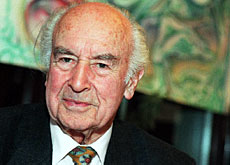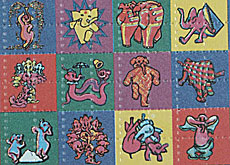Father of LSD celebrates 100th birthday

Albert Hofmann, the Swiss scientist who discovered the psychedelic drug LSD (lysergic acid diethylamide), turns 100 years old on Wednesday.
The drug, famed for its hallucinogenic trips, was popular among the 1960s hippy generation. But it was also once a well-respected treatment for a variety of psychiatric disorders.
To mark Hofmann’s centenary, an international symposium, entitled LSD – Problem Child and Wonder Drug, is being held in Basel from January 13-15. Hofmann is scheduled to attend.
Swiss President Moritz Leuenberger congratulated the scientist on his birthday and saluted him as a “great researcher of the human consciousness”.
Hofmann discovered LSD in 1938 while he was working for the Basel-based pharmaceutical company, Sandoz (which later merged with Ciba-Geigy to become Novartis).
Researchers were looking at ways of identifying and synthesizing chemical compounds from plants.
Hofmann chose ergot, a fungus that grows on rye and other cereals, which was formerly used by midwives to stop bleeding after childbirth.
It also causes ergotism, a form of fungal poisoning, which was a common complaint among medieval pilgrims.
Hofmann managed to isolate some of ergot’s active substances, including a drug that stops post-natal haemorrhaging.
Discovery
But he is best remembered for his accidental discovery of LSD in 1938. Although many of his colleagues remained sceptical, Hoffman decided to reinvestigate the drug – originally for its circulation-boosting properties – five years later.
“By chance, I got a whiff, and immediately felt exhilarated,” he recalled in an interview with swissinfo in 2001 when he turned 95.
He continued his research and Sandoz produced and sold the first LSD tablets in 1947, mainly as a treatment for alcoholism and other psychological disorders.
LSD became popular as a recreational drug, especially in the United States. It was a favourite among the hippy and art set, with “pop art” painters Jasper Johns and Andy Warhol, as well as writers Tom Wolfe and Aldous Huxley, claiming their work was influenced by the drug.
Its widespread use caused an outcry, which eventually led to a worldwide ban at end of the 1960s. It also gradually fell out of favour in the medical world. Sandoz stopped producing it in 1966.
Bad trips
Apart from generating a high, where the senses, perceptions and moods are intensified and altered, LSD can also cause terrifying “bad trips” in which the user suffers panic attacks or paranoia.
This is something that Hofmann has experienced. Shortly after his experience with LSD, Hofmann decided to use himself as a guinea pig and took 0.25 milligrams, three times the amount needed for a high.
He cycled home from the lab and had his first intense acid trip. “It was a horror trip,” he remembers.
LSD is acknowledged to complicate mental health problems, but it is not considered an addictive drug.
Hofmann – who became known after his discovery as Mr LSD – warned that it is no “pleasure drug” and that if used indiscriminately, can be dangerous.
But he remains convinced of the substance’s therapeutic properties for the mind.
Hofmann has researched the use of stimulant drugs in traditional cultures around the world and found evidence of natural LSD being used by Mazatec Indians in Mexico, as well as by the ancient Greeks in fertility rites.
Close to nature
The former chemist now lives with his wife in the idyllic setting of Leimental, near the French border.
The sprightly centenarian, who no longer takes the drug, is still in good health. He continues to enjoy nature and takes a daily stroll through the countryside near his home.
His curiosity about the natural world led him to become a chemist, and later to carry out experiments on LSD on himself, he has said.
Hofmann remained with Sandoz until 1971. He has written widely on LSD and on questions of spirituality and consciousness.
The scientist recently summed up his personal philosophy in an interview with Swiss-German television.
“Most human beings live nowadays in big cities, in a dead world,” he said. “They go to the moon, but they don’t even know how to look at a starry sky.”
“And yet, all we need to be happy is not to be found in the beauty of human invention, but in nature’s own beauty.”
swissinfo
An international symposium, entitled LSD – Problem Child and Wonder Drug, is being held in Basel from January 13-15 in Hofmann’s honour.
Apart from Hofmann, more than 80 experts are expected to attend the event.
Hofmann has received congratulations from Swiss President Moritz Leuenberger.
LSD is said to be one of the most potent hallucinogenic substances where senses, perceptions and moods are intensified and distorted.
It can complicate mental health problems, but it is not considered an addictive drug.
A trip can last up to 12 hours. LSD can also cause flashbacks where part of the trip is re-experienced after the event.

In compliance with the JTI standards
More: SWI swissinfo.ch certified by the Journalism Trust Initiative


You can find an overview of ongoing debates with our journalists here . Please join us!
If you want to start a conversation about a topic raised in this article or want to report factual errors, email us at english@swissinfo.ch.